
CBSE Class 12 Physics Notes Chapter 5: Here are the notes for CBSE Class 12 Physics Chapter 5 Magnetism and Matter. This chapter explains the magnetic properties of materials and their response to external magnetic fields.
It covers the concepts of magnetic susceptibility, magnetization, and the types of magnetic materials such as diamagnetic, paramagnetic, and ferromagnetic substances. These notes provide a detailed understanding of how matter interacts with magnetic fields and the fundamental principles governing these interactions.CBSE Class 12 Physics Notes Chapter 5 Magnetism and Matter Overview
These notes are prepared by the subject experts of Physics Wallah provides a detailed overview of CBSE Class 12 Physics Chapter 5 Magnetism and Matter. It covers key topics such as magnetic susceptibility, magnetization, and the classification of materials into diamagnetic, paramagnetic and ferromagnetic types. The notes also explain important phenomena like hysteresis and the behavior of materials in magnetic fields. This detailed overview helps students grasp the core principles of magnetism and their applications in various materials.CBSE Class 12 Physics Notes Chapter 5 PDF
The PDF link for CBSE Class 12 Physics Notes Chapter 5 Magnetism and Matter is available below. The notes cover important topics like hysteresis and the classification of materials into diamagnetic, paramagnetic, and ferromagnetic types. Access the PDF to explore detailed explanations and illustrations that will enhance your understanding of magnetism and its effects on various substances.CBSE Class 12 Physics Notes Chapter 5 Magnetism and Matter PDF
CBSE Class 12 Physics Notes Chapter 5 Magnetism and Matter
Here we have provided CBSE Class 12 Physics Notes Chapter 5 Magnetism and Matter-Magnetic Field and Force
The magnetic field is a region around a magnet where materials or charged particles experience a magnetic force. This force can either attract or repel the charged particles depending on their relative positions. The magnetic field is generated by moving charges, such as currents in wires, and its strength and direction determine how strongly it influences other charges within its reach. The force experienced by a charged particle in a magnetic field depends on the charge's velocity, the magnetic field strength, and the angle between the particle's velocity and the field direction. This interaction between the magnetic field and moving charges is fundamental to various physical phenomena and applications.
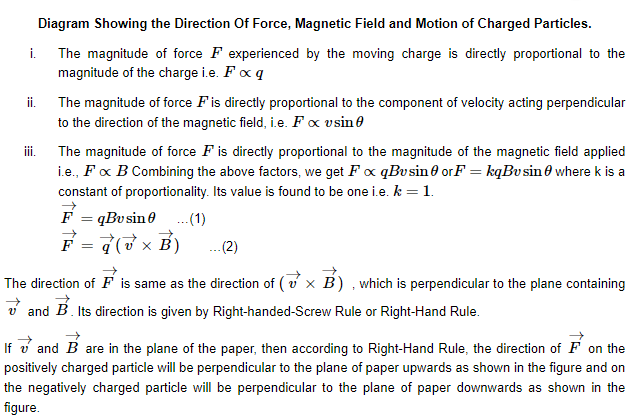
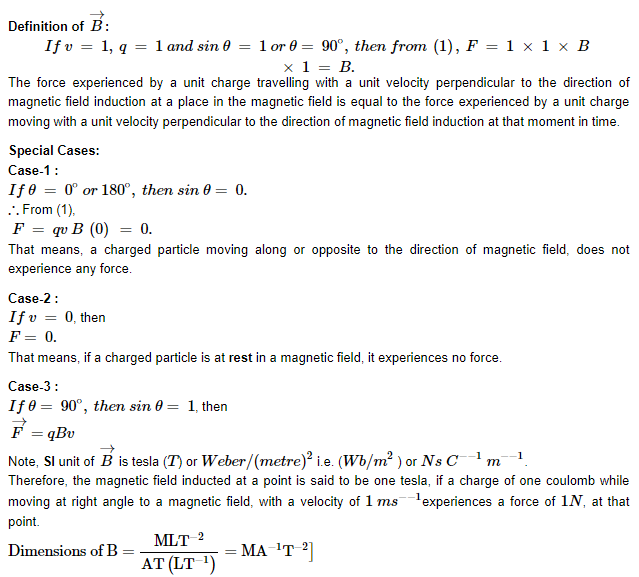
Lorentz Force
The Lorentz force is the force exerted on a charged particle moving through a region where both electric and magnetic fields are present. This force is a combination of the electric force and the magnetic force acting on the particle.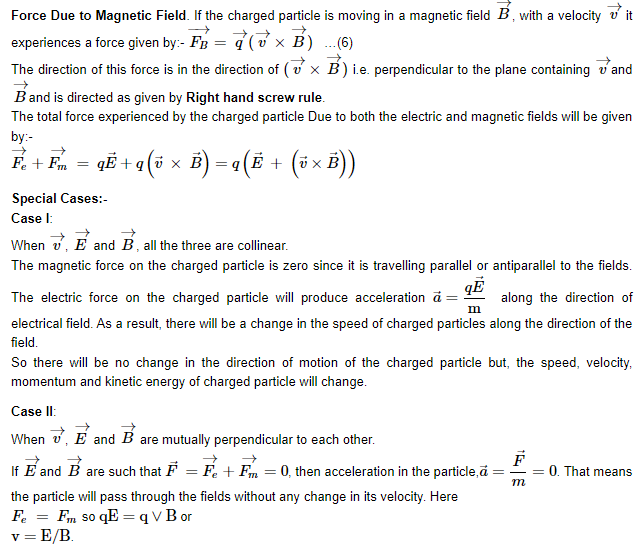
Motion of a Charged Particle in a Uniform Magnetic Field
When a charged particle moves through a uniform magnetic field, it experiences a force that causes its trajectory to bend into a circular or spiral path. This behavior is due to the Lorentz force, which acts perpendicular to both the velocity of the particle and the magnetic field.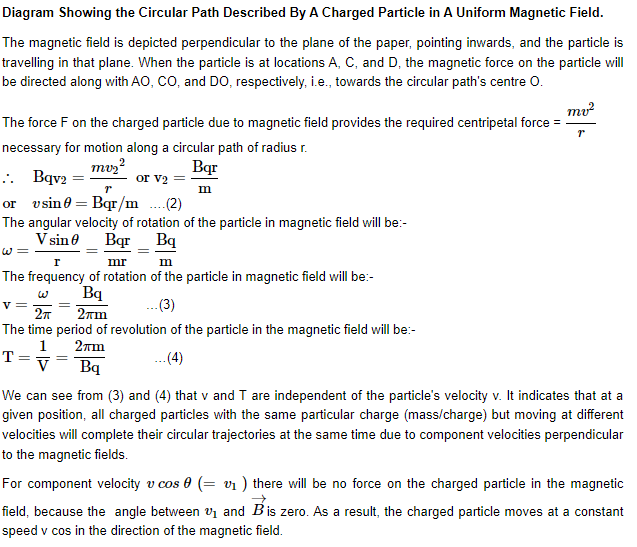
Motion in Combined Electron and Magnetic Fields
Velocity Filter
A velocity filter is a device that uses crossed electric and magnetic fields to select particles based on their velocity, irrespective of their mass or charge. It is designed to allow only those particles with a specific velocity to pass through, while others are deflected.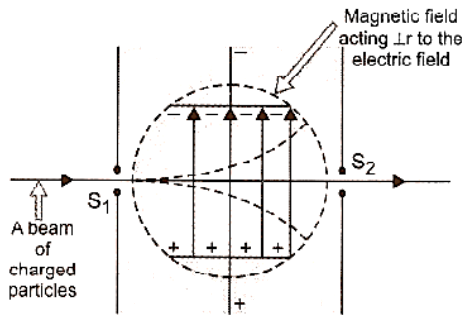
Force on a Current-Carrying Conductor Placed in a Magnetic Field
Consider a straight cylindrical conductor P Q of length l , area of cross-section A, carrying current I placed in a uniform magnetic field of induction, B . Let the conductor be placed along the X-axis and the magnetic field be acting in X plane making an angle θ with X-axis. Suppose the current I flows through the conductor from the end P to Q figure. Since the current in a conductor is due to motion of electrons, therefore, electrons are moving from the end Q to P .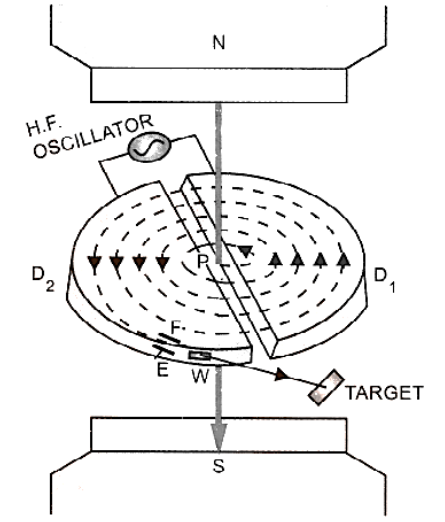
How Are Magnetic Materials Classified?
Magnetic materials are classified based on their magnetic properties and how they respond to an external magnetic field. Here’s a simple explanation of the three main types:Diamagnetic Materials :
- Magnetic Susceptibility (χ) : Negative and very small.
- Behavior : Diamagnetic materials create an induced magnetic field opposite to the direction of the applied external magnetic field. They are weakly repelled by magnetic fields.
- Examples : Bismuth, copper, and graphite.
- Characteristics : These materials do not retain any magnetic properties once the external magnetic field is removed.
Paramagnetic Materials :
- Magnetic Susceptibility (χ) : Positive and small.
- Behavior : Paramagnetic materials have a weak and temporary magnetic attraction to an external magnetic field. The magnetic moments align with the external field but only while the field is applied.
- Examples : Aluminum, platinum, and certain metal ions.
- Characteristics : The alignment of magnetic moments in paramagnetic materials is relatively weak and disappears when the external field is removed.
Ferromagnetic Materials :
- Magnetic Susceptibility (χ) : Large and positive.
- Behavior : Ferromagnetic materials have a strong magnetic attraction and can retain magnetic properties even after the external magnetic field is removed. They exhibit spontaneous magnetization, meaning their magnetic moments align in the same direction even without an external field.
- Examples : Iron, nickel, and cobalt.
- Characteristics : These materials have high magnetic permeability and can be permanently magnetized, forming strong magnetic domains.
Permanent Magnets
Permanent magnets are materials that, when magnetized, retain their magnetic properties for a long time, even after the external magnetic field is removed. These magnets are made from ferromagnetic materials, such as iron, cobalt, or nickel, which have strong magnetic properties and can sustain their magnetization.Benefits of CBSE Class 12 Physics Notes Chapter 5 Magnetism and Matter
- Clear Conceptual Understanding : The notes provide a thorough explanation of fundamental concepts related to magnetism and matter including the types of magnetic materials, magnetic fields, and forces. This clarity helps students build a solid foundation in understanding magnetic phenomena.
- Simplified Explanations : Complex topics such as the behavior of magnetic materials and the principles of magnetism are broken down into simpler terms. This makes it easier for students to grasp difficult concepts and apply them to problems.
- Preparation for Exams : By covering essential topics and providing practice problems, the notes help students prepare effectively for their exams.
- Comprehensive Coverage : The notes cover all critical aspects of the chapter ensuring that students are well-prepared for both theoretical questions and practical applications. This comprehensive approach supports thorough learning and review.
CBSE Class 12 Physics Notes Chapter 5 Magnetism and Matter FAQs
What is Magnetism?
Magnetism refers to the phenomenon by which certain materials exert attractive or repulsive forces on other materials. This occurs due to the alignment of magnetic moments within the material.
What is Lorentz Force?
The Lorentz Force is the force experienced by a charged particle moving in the presence of both electric and magnetic fields.
What is Magnetic Susceptibility?
Magnetic Susceptibility is a measure of how much a material becomes magnetized in an applied magnetic field. It indicates whether a material is diamagnetic, paramagnetic, or ferromagnetic.
How does a velocity filter work?
A velocity filter uses crossed electric and magnetic fields to select particles of a specific velocity. Particles of different velocities are deflected differently by the fields, allowing only those with a specific velocity to pass through.
Talk to a counsellorHave doubts? Our support team will be happy to assist you!

Check out these Related Articles
Free Learning Resources
PW Books
Notes (Class 10-12)
PW Study Materials
Notes (Class 6-9)
Ncert Solutions
Govt Exams
Class 6th to 12th Online Courses
Govt Job Exams Courses
UPSC Coaching
Defence Exam Coaching
Gate Exam Coaching
Other Exams
Know about Physics Wallah
Physics Wallah is an Indian edtech platform that provides accessible & comprehensive learning experiences to students from Class 6th to postgraduate level. We also provide extensive NCERT solutions, sample paper, NEET, JEE Mains, BITSAT previous year papers & more such resources to students. Physics Wallah also caters to over 3.5 million registered students and over 78 lakh+ Youtube subscribers with 4.8 rating on its app.
We Stand Out because
We provide students with intensive courses with India’s qualified & experienced faculties & mentors. PW strives to make the learning experience comprehensive and accessible for students of all sections of society. We believe in empowering every single student who couldn't dream of a good career in engineering and medical field earlier.
Our Key Focus Areas
Physics Wallah's main focus is to make the learning experience as economical as possible for all students. With our affordable courses like Lakshya, Udaan and Arjuna and many others, we have been able to provide a platform for lakhs of aspirants. From providing Chemistry, Maths, Physics formula to giving e-books of eminent authors like RD Sharma, RS Aggarwal and Lakhmir Singh, PW focuses on every single student's need for preparation.
What Makes Us Different
Physics Wallah strives to develop a comprehensive pedagogical structure for students, where they get a state-of-the-art learning experience with study material and resources. Apart from catering students preparing for JEE Mains and NEET, PW also provides study material for each state board like Uttar Pradesh, Bihar, and others
Copyright © 2025 Physicswallah Limited All rights reserved.
Get App









